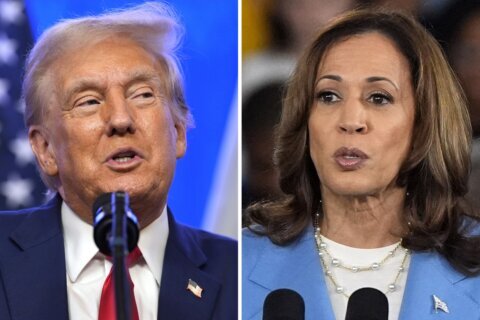The 2024 presidential election may be one of the biggest market-moving catalysts this year. It’s too early to speculate about a potential winner, but the January New Hampshire primary and Iowa Republican caucus results suggest a rematch between Democrat Joe Biden and Republican Donald Trump.
[Sign up for stock news with our Invested newsletter.]
This election year will bring several challenges for investors and politicians alike. Unfortunately, the S&P 500’s past performance during U.S. presidential election years suggests investors could see some lackluster returns in 2024. Here are some things to keep in mind this election year:
— S&P 500 performance in election years.
— Top election year market sectors.
— Market performance under Biden versus Trump.
— 2024 investing strategy.
S&P 500 Performance in Election Years
The S&P 500 has averaged a 7% gain during U.S. presidential election years since 1952, according to an LPL Financial study that includes data from the S&P 500’s precursor index. While a 7% gain is far from disastrous, it is also well short of the 17% average S&P 500 gain in the year prior to an election year. It’s also below the roughly 10% average annual total return for the S&P 500 in the typical year. Of course, it’s important for investors to remember that past performance does not guarantee future returns, and there have only been 17 presidential elections since 1952.
The good news for investors in 2024 is that the S&P 500 has not declined during a presidential re-election year since 1952 and has averaged a 12.2% annual gain in re-election years. A presidential re-election year is the fourth year of a first-term president’s administration in which they are seeking re-election for a second term.
The presidential election is only one of many factors that influence the stock market during election years, but analysts say there is good reason for investors to expect strong returns in re-election years like 2024.
Presidents seeking re-election will often “prime the pump” by implementing fiscal stimulus measures and pro-growth regulatory policies to support the economy and the labor market.
The federal funds interest rate is currently at its highest level in 22 years as the Federal Reserve continues its battle with inflation. Elevated interest rates increase borrowing costs for consumers and businesses, weighing on economic growth. U.S. gross domestic product grew 3.3% annually in the fourth quarter, but economists expect that growth rate to slow in 2024. While the chances of an imminent U.S. recession have fallen in recent months, the New York Fed’s recession probability model suggests there is still a 61.4% chance of a recession within the next 12 months.
To make matters worse, Biden may have limited opportunities to add economic stimulus measures in 2024, as Republicans control the House of Representatives and are unlikely to cooperate. However, the majority of the spending from the 2022 Inflation Reduction Act is slated for fiscal years 2024 through 2026, which could help support the economy and the stock market this election year.
Jeffrey Buchbinder, chief equity strategist for LPL Financial, says the Federal Reserve’s ability to navigate a so-called soft landing for the economy in 2024 will be the key to stock market upside and the election outcome.
“Those soft-landing prospects are brighter given it’s an election year, which could bring additional stimulus from the Biden administration, with or without congressional approval (regulatory actions, or inactions, can also provide an economic lift),” Buchbinder says.
“The White House is well aware that no U.S. president in modern history has been re-elected when a recession occurs during an election year.”
Top Election Year Market Sectors
From a sector standpoint, the financial services and energy sectors have been top performers during presidential election years since 1973, according to Comerica Bank. The technology sector, which has been by far the top overall performer in the past 50 years during non-election years, has been one of the worst-performing market sectors during presidential election years. The materials sector is the only sector that has performed worse than the technology sector during election years.
Investors betting the pattern holds true again in 2024 can increase their allocation to financial services and energy sector exchange-traded funds, such as the Financial Select Sector SPDR Fund (ticker: XLF) and the Energy Select Sector SPDR Fund (XLE).
[READ: Recession 2024: What to Watch and How to Prepare]
John Lynch, chief investment officer for Comerica Wealth Management, says the positions and policies of the candidates are largely what moves specific market sectors, and those platforms can change on an election-to-election basis.
“A major issue with sector implications in one election year may prove to be a non-factor in another election. Moreover, issues like Medicare-for-All can have bifurcating effects on sectors with sub-industry winners and losers within the same sector,” Lynch says.
Different market sectors can also outperform depending on which candidate is leading in the polls, and it’s too early at this point for investors to anticipate a winner in 2024.
Market Performance Under Biden vs. Trump
Given the two leading candidates in the 2024 election both have experience in the White House, investors can also take a look at how the stock market has performed during each candidate’s time in office.
Comparing Trump’s first three years in office to Biden’s, the S&P 500 gained 43.1% overall, or about 12.9% annually. Under Biden, the S&P 500 cumulatively gained 23.9%, or about 7.6% annually, according to an analysis by Facts First.
Trump’s stock market outperformance relative to Biden is even stronger when looking at the tech-heavy Nasdaq Composite. The Nasdaq gained 62.5% under Trump, or about 17.9% annually. Under Biden, the Nasdaq is up just 12% overall, or 3.9% on an annual basis.
It’s easy to give Biden and Trump credit or blame for stock market performance during their respective presidencies, but the COVID-19 pandemic dealt extreme disruptions to the economy and the market in both 2020 under Trump and 2021 under Biden. These disruptions severely muddied the waters when it comes to economic and market performance data. For example, the U.S. economy averaged just 2.6% annualized GDP growth under Trump’s first three years compared to 6.9% under Biden. However, those numbers are both skewed by the outlier 2.7% GDP drop during the pandemic-related economic shutdowns in 2020.
2024 Investing Strategy
The upcoming election year may prove to be unpredictable and volatile. Fortunately for investors, analysts are generally optimistic about the outlook for stock prices in 2024.
The consensus analyst price target for the S&P 500 is currently 5,280.39, according to FactSet, which represents roughly 6.5% upside from the Feb. 2 close over the next 12 months. On a sector basis, analysts see the most valuation upside for the energy sector (+19.7%), which has historically been a top performer during re-election years.
Tom Logue, senior equity strategist for Commonwealth Financial Network, says the S&P 500’s positive January, including making its first new all-time highs in two years, bodes well for its outlook for the rest of the election year. In each of the eight election years since 1957 in which the S&P 500 has gained at least 1.5% in January, the index has generated positive returns for the remaining 11 months of the year and averaged an 11.6% additional gain over those 11 months.
“Historical price returns are far from a guarantee of future price returns. Nonetheless, a strong January for the S&P 500 further increases my confidence that 2024 will be a strong year for the equity markets,” Logue said in a report.
More from U.S. News
2024’s 10 Best-Performing Stocks
How Do Conflicts and War Affect Stocks?
Election 2024: How Stocks Perform in Election Years originally appeared on usnews.com
Update 02/05/24: This story was previously published at an earlier date and has been updated with new information.







